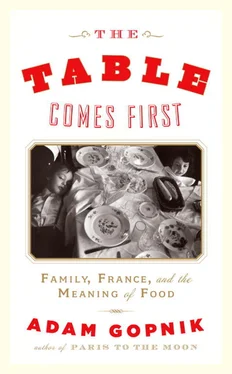When I next got to Paris, later that summer, I realized that I had heard some of this before: American critics had been complaining for a while that French cooking, which had led the world in the idea that food might be art, had become stereotyped, unreal, and remote from life, and the complaint had at moments echoed in France. I had been one of these critics, and not the quietest or most decorous, voicing the complaint myself at length in an essay back in the nineties, to the anger of some in France and the pained acceptance of many others. (The critic Michael Steinberger had more recently gotten a good book out of the same theme.)
The grounds of the complaint, as I had made it once, and others since, wasn’t just against French food, which was still as good as ever, but against the stasis in French cooking. Italian cooking, in particular, had established itself as the base, the longed-for country, the dominant style. In England, Italy had cleared all before it, become what France had been a century before, when Elizabeth Pennell took the greatness of French cooking for granted, and spaghetti had been sneaked in as a strange exotic possibility. Ruth Rogers and Rose Gray had, at the River Café in London, created a kind of satellite version of Italy which some of us thought as good as anything in the Old Country. More important, they had made Italian cooking—expressed strictly in English, without any of the patina of the moda antico —the natural language of the English cook. In America, Italian cooking, under the more temperamental presence of Marcella Hazan, still had something Old World to it, was “spoken” with an accent—Italian restaurants still had Italian waiters—but it was what men with expense accounts wanted for lunch and what women with children cooked for dinner. The grammar of French cooking itself—a lump of protein sautéed in a pan, the pan cleansed by a liquid, the liquid reduced to a sauce—which had been so radically new only a century before, now seemed tired on your plate and lethal to your heart. In its place, a variety of techniques, some old and Asian, some new and Catalonian, had taken their place: the grilled fish with a relish, the sweet-savory quick cook and slow simmer, based on curries and stir-fries, had become dominant. A kind of West Coast offense (short gains with quick slants) had taken over cooking—lots of small, intensely flavored plates instead of one big rich main. We live in a tapas civilization—quick-hitting bursts of information and gossip and malice—and a veal chop with butter and mustard sauce or a filet of beef with pastry and peppercorns suddenly seemed as dated as the four-hundred-page novel brooding on a single woman’s plight.
As always in life, you voice a complaint against your beloved only to regret it later. “A Lover’s Complaint” is the title of the first love poem, not the last. In New York, the empire of the French restaurant, which in my first years there had stretched from Le Lavandou, on East Sixty-first Street, to Le Périgord, on East Fifty-second, one long imperial highway stretching across the Upper East Side, had been reduced to a single restaurant. On birthdays we went to La Grenouille for the old food—cheese soufflés and Dover sole with white sauce and filet of beef with those green peppercorns—and cherished the last refuge of the red banquette and the towering bouquet. There was still good brasserie food around—the simple country-based food that had itself been fast food in France a century before, grilled chicken and choucroute, which is just franks and beans. That you could find all over. But I longed for another kind of French meal: that veal chop with mustard sauce, a purée of endives and a small potato gratin, a sharp salad with a smooth and tangy goat cheese and then a bright and supple apricot soufflé. A foie de veau with raisins and mustard-tarragon butter, and an endive salad and île flottante and profiteroles. Lobster à l’Américaine, sole à la neige, poulet à la normande . You didn’t find them much even in Paris, for while there might be stasis in French food, it was stasis that had frozen the high end and the lower end while leaving out the middle. The cuisine bourgeois was passing even as the old bourgeois themselves were. City food for city people. Food for twilight times. You couldn’t find that anymore.
Not long ago, I had coffee with Benedict Beauge, a French writer who occupied the necessary ground between history and food writing. “We no longer have a crisis of French food,” he said with the bright gloom, the Epicurean skepticism, of the French food lover. “Now we have a crisis of the French restaurant.” He meant, I discovered, that the best new cooks in France—Guy Martin at Le Grand Véfour, Passard, Pierre Gagnaire at his own restaurant—were as good as anyone, having absorbed the lessons of the Spanish with a greater aplomb, but their places were still rooted in the old Michelin system: three-star temples, fit for a voyage. There was a kind of permanent misfit between the cooking talent and the culinary temple. The idea of “worth a voyage” expresses its nineteenth-century nature. We now think of food being worth a revelation. And revelations, we know, happen in eccentric places, caves and chapels.
I was moved enough by memories of the old classic New York French restaurants—all those stuffed chicken breasts and tiny copper serving pots, all those waiters, by turns obsequious and imperious, all that puff pastry and red velvet upholstery—that I thought to salute them, or elegize them internally, at least, by being present for the last lunch at La Côte Basque. The classic, famous old restaurant was closing on March 7, 2004, as its chef-proprietor, Jean-Jacques Rachou, neared seventy. Along with the deaths of Lutèce and Gage & Tollner, the event marked the end of something or other, at a time of who knows what—but it needed to be observed.
The Côte Basque that ended was not the Côte Basque that began. That one, familiar to readers of Truman Capote (who set a gossipy story there), was actually one block over, east of Fifth Avenue, in the space that became a Disney Store. The entire operation—the tables, the banquettes, and the murals of the Basque coast by Bernard Lamotte that gave the place its name—was dislodged in 1995, and replanted more or less successfully in the new space farther west.
Historians, or, at least, chroniclers of the New York restaurant world, will also recall that the original Côte Basque was intended, rather defiantly, not to be what it ended up being—a temple of haute cuisine. It was Henri Soulé’s second restaurant, the “relaxed,” ostensibly bistro-ish alternative to his Le Pavillon, which was itself a relic of the 1939 World’s Fair. As Joseph Wechsberg explained in The New Yorker some forty years ago, the Pavillon was the first restaurant in New York to be emphatically and uncompromisingly major—three-star cooking, as they did it in Paris—and La Côte Basque was the first to be major in a minor way. (Reading Wechsberg now, one is struck by how tired the food sounds, much of it made earlier in the day and presented as a buffet froid , to be admired as people entered the restaurant.) La Côte Basque, however, became the fashionable place, on the universal principle that whatever is defined in advance as exclusive is uninteresting, while whatever is defined in advance as informal can have an overlay of exclusivity bestowed upon it. La Côte Basque, which stumbled after Soulé’ death, was revived in the early eighties by Jean-Jacques Rachou, who had earlier created what was for a spell one of the best places in New York, Le Lavandou. Rachou was the master of a brief rococo interregnum. (This had to be a food-magazine cover line back then: “The Rococo Interregnum.”) His chicken was still stuffed; his fish still imported; and if he met a tournedos he greeted it with a slice of foie gras and a truffle sauce. He was mostly famous for the free-form inventiveness of his plates, which often looked, one critic wrote, if memory serves, “like the flags of some effete nation.” The style had its moment, and the restaurant got a cheerful second life, which is now over. There is a second life for institutions when people in their twenties arrive; and another second life when people in their fifties return—the second sort of second life was the kind that La Côte Basque had.
Читать дальше












